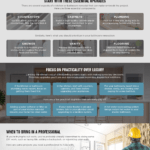
Coming from a homeowner’s perspective, it’s not a pleasant experience to see your house getting flooded. There could be several reasons, for instance, you have a faulty pipe, got hit by a storm, or perhaps experienced heavy rain. Imagine the vast amounts of water gushing into your house, which is messy to deal with, while witnessing the spoiled furniture, wrecked place, and even the possibility of mold.
Depending on how extensive the damage is, you may be in for the long haul. So, to save you from the trouble of getting overwhelmed, here’s a list compiled for you. So with a proper plan in place, you can save yourself substantial money. So here’s what you need to do when you get hit with massive flooding:
- Prepare For The Worst
Water damage is always massive. So when you’re inspecting the area, prepare yourself for the worst. When you’re mentally ready to tackle the load ahead of you, your anxiety level may drop. You’re able to formulate a plan for yourself and spring into action. First, detect where the water is coming from. In any case, whether it is a pipe burst or it rains through your roof, you must immediately call a professional to help you survey the damage. However, a water damage advisor can take a survey and provide you with details of the damage and the repair process. When you have these answers, it’s time to get your hands dirty.
- Pull Your House Apart
You need to clear the space. Drain all the excess water by pumping it out of your house. Once the place is nice and damp, take out all the soaked items. You may need to tear the wallpaper, pull out the carpets and lift the furniture. If the water is on several levels of your house, you may need to repeat the process. You may want to take all these materials out of your home and into the yard. Clear out the space entirely so you can drain your house correctly.
- Let It All Dry
You may need to call disaster recovery right away. The more you waste time, the chances of mold growing get higher. Start drying everything that is in your house. Inspect your air conditioning and heaters for water damage. If they’re in the clear, you need to turn them up to help dry water faster. If you’re wondering when the remodeling part will start, you can’t start it right away. You need to have a house to remodel. Unless you reclaim your space from the water seepage, you can’t fix anything.
- Inspect For Mold
Even if you’re swift, there is still a chance the mold sneaks up on you. So, after you cleared your house, inspect the infrastructure. Mold will grow anywhere damp and slightly wet. The most common places for mold are bathroom walls and in between wooden sheets. If you see mold making an appearance, you need to get help. Mold is easy to detect; it discolored the walls and the floor. So you can tell where mold has started acting up. It rots the structure, so you can’t mount anything on top of the mold. Once the mold is out of the way, you can begin the process of rebuilding.
- Call Your Insurance Company
House repair can easily be one of the most expensive processes. Therefore you must have house insurance. Insurance companies will come and inspect the damage themselves. That is not because they need to know how much adjustment your house will need. After they draw up their inspection, the company will take care of most of the costs. You may have minor payments to do yourself. However, nothing will curb your budget.
- Start The Process Of Remodeling
Structure damages need immediate addressing. You may want to hire a contractor and let them get rid of old insulation and structure. They may need to replace the roof and even ceilings depending on what the water damaged. After they lay down a new structure, you should get the contractors to repaint your walls or add wallpaper to the walls. The first step may take time. You need to decide how much patching you need.
- Consider The Upgrades You Need
Remodeling makes you consider what your house needs. You may not stock up on previous appliances. You may also need new furniture. So think about what your house needs the most and what you can manage. You don’t need to compromise style for functionality but instead of stuffing your home, give it room to breathe. You may want to invest in waterproof furniture and even waterproof the house where you can. Now, all of these new upgrades may cost you more than you intend, therefore prioritize what your house needs.
- Fix The Wiring and The Pipes
Water damage tends to go in places where it can cause maximum damage. You may have wires that have water. Even if the wires look fine but are damp, you can risk a short circuit. So make sure you get all these core components of your house changed. Please make sure the new pipes you choose are far more durable with protective paint on them. The same goes for the wires. They need to have proper insulation.
- Find Refuge
It would help if you kept in mind remodeling and fixing a house after substantial damage takes time. Even after the job is complete, you need to ventilate your home. So you may need to find a place to stay. Don’t rush the process. It would help if you had ample time to recover your house. You can visit your home as often as you like but stay away from paint fumes. You can check into a motel or a hotel. It is also not unusual to live with a relative for a while. However, it would help if you figured these dynamics with your family.
- Keep Making Decisions
Unlike buying your first house, remodeling is vastly different. You may start with a plan and change your mind many times. That is a part of the process. You may find a suitable way to remodel your house, which is cheaper than the original plan. Don’t be afraid to pitch your new idea to the contractors. After all, you’re trying to reclaim your space. So, you want to make decisions that last you a few hours. Part of your decision-making should also include reviewing your insurance. The end goal of your planning is to have a sturdy house.
Wrap Up
Water can leave lingering damages in your house, which can impact the very infrastructure of your accommodation. Unlike other times of disasters with water, timing is everything. So you need to be quick on your feet and salvage your house. Hire professionals right away and let them start the process of draining. You want to dry the space to avoid mold settling in quickly. If mold does happen to occur, once again, remove it right away. When you’re happy with the clearing process, start the rebuilding process. You may need to make serious decisions about what goes on in your new space. When you’re happy with the restructure, move right back in.






